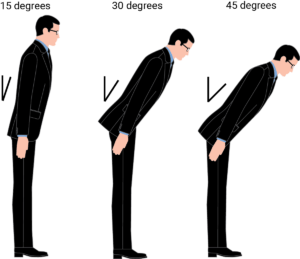
Argos Multilingual and Lokalise Extend Language Technology Partnership
Blog
・9 min read
Many of us change our language slightly depending on who we’re around, but what if you had a different style of language for every social context?
The Japanese language has a system like that: we have several levels of formality in our language built into the very grammar we use. Depending on our relationship to the person we’re speaking with, Japanese speakers adjust their language to show the proper amount of respect for their conversational partner. Like English speakers, we choose specific words and make our sentences longer, but unlike languages without specific registers of formality, we even choose different verb forms depending on the level of politeness the situation requires. You can convey a lot of information about yourself and make a good impression — or an unforgivable mistake! — by using appropriately formal language in a first introduction.
Your relationship with another person and rank relative to them determines which level of language to use. For example, a parent ranks above a child, a teacher above a student, and a customer above a salesperson. Close family members, friends, and children use informal language to talk to each other. But when you’re talking to a colleague or another adult, you may use more formal language.
For business clients, strangers, and those of a higher social status, there are three levels of additionally formal language (these high-formality levels are put under an umbrella word, keigo) to choose from. Once you’ve established a relationship with your client, you may shift to a more informal language, but only once you’ve shown respect.

Children learn how to use formal language from their parents and family members, but often school is the first chance for them to really practice it. When talking to senior classmates in after-school clubs, younger students use formal language. Because of the social hierarchy in clubs, younger students must show a great deal of respect for upperclassmen.
Even this practice does not completely prepare students for the working world, however, and many must do extra study to prepare for the most difficult use of honorific speech: the job interview. If they do not know how to speak formally and politely to the interviewer, they may not be considered for the job.
The other most important instance when you need to use formal language is meeting your future parents-in-law. If you mess up, they will likely not approve of you!

As students entering the workforce know, choosing the right level of formality matters, especially in business communications. When translating email or other business communications, knowing the right polite language to use can make the difference between a good relationship with a new client or a strained one–or no relationship at all.
These days, many companies try to project a friendly image, and many have abandoned super formal language for a polite but friendly middle level of formality, even on client-facing websites. You will not find informal writing on a website though, even if the “tone” of the company in English is very relaxed. A certain level of politeness must be maintained.
When you are crafting or translating written or face-to-face correspondence (especially email) with clients, formal language use is a must. There are actually three types of polite speech for business use. Some clients may prefer a less formal tone; others may prefer to keep business communications in a formal register.
1) Sonkei-go (尊敬語: showing respect)
“Have you already watched the movie?” (その映画をご覧になりましたか?)
In this case, the verb “watched” is adapted to the politest version. This version of the verb should always be used when talking to clients. The client is the one doing the action so the action word needs to be formal.
2) Kenjo-go (謙譲語: showing respect by “downgrading” yourself)
“I have read your proposal.” (提案書を拝見しました)
In this phrase, the verb “read” is adapted to show that the person “humbly read” what a “superior” had written. It shows respect for the proposal and humbles the reader. This type of formal language is often used when talking to colleagues. You are the one doing the action so the action word uses a humble version.
3) Teinei-go (丁寧語: showing politeness)
“It’s raining today.” (今日は雨が降っています)
Although it isn’t addressed to a specific person, this phrase is a generally polite way of saying it is raining. This form of politeness is used all around.
It can be easy to mix the different types of formal language up. For instance, if you are talking to your boss, you must use polite language with him. But if you are talking to an external client about your boss, you should use language that downgrades both your boss and yourself in the conversation. When determining a person’s rank, it’s important to consider whether they’re inside or outside your group. Since the client is important and outside your company, the client should be held above those inside the company even if you are discussing your superior.
Another example of a common mistake made in business correspondence is to duplicate keigo. For example:
“Have you already seen our website?”
correct: 弊社の Web サイトはご覧になりましたか?
incorrect: 弊社の Web サイトはご覧になられましたか?
In this case you are simply adding one level of politeness to the verb “seen”
As keigo has several different ways of indicating politeness, doubling up on the keigo actually makes the grammar incorrect rather than ultra-polite.
If you’re working with clients in person, another way to show respect is to bow. Like the rules for formal language, the conventions for bowing change depending on the amount of politeness you want to show. Typically, the deeper your bow, the greater respect you show. A 15° bow is a casual bow, one you might use when greeting someone. A 30° bow is more formal and shows respect, and it’s the most common bow in business settings. Use a 45° bow to show deep gratitude, to apologize, or to be very polite.

I sometimes see non-Japanese people using Japanese bowing conventions and it makes a very good impression. If you want to look Japanese or show respect when working in Japan, learning how to bow is the easiest way.
Mastering keigo in business communications is more difficult, however—I’ve even seen client reviewers and translators choose the wrong terminology or grammar. When translating communications to customers, it’s especially important to know how formal your tone and language should be. With a little knowledge of the customs—and some help from our experts at Argos—you can navigate these levels with ease!
To get a project started in Japanese, (politely) get in touch with our experts.
What to read next...
Want to know more?
The latest industry news, interviews, technologies, and resources.
View all resourcesGet in touch
We are committed to giving you freedom of choice while providing subject matter expertise and customized strategies to fit your business needs.
Contact us